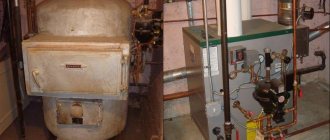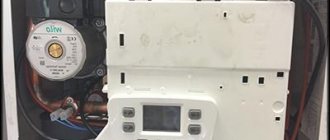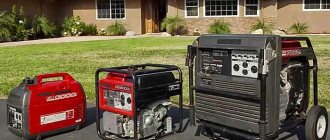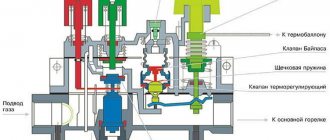A year ago, I tried to understand why regular car batteries cannot be used instead of specialized ones in uninterruptible power supplies. That article examined several horror stories from sellers of specialized batteries, and also measured the capacity of two batteries, each of which consists of four car batteries that worked in a UPS for a year. Unfortunately, I did not think of making such a measurement immediately after installing fresh batteries, but I promised to repeat the measurement a year later so that I could understand how much the battery capacity had decreased over the year. I planned to do this in the form of a comment with updated data, but during the measurement process I noticed that while the UPS was running on batteries, the boiler connected to it was not working.
A little background
A year ago, when the UPS was installed, the gas boiler was as simple as possible, a minimum of electronics, manual ignition.
Actually, manual ignition was the only drawback of the boiler, because when the power was turned off, the boiler extinguished the torch for safety reasons, and was not able to light it back up. The UPS solved this problem, but there was another problem: with a strong gust of wind, the torch could simply blow out. This did not happen often, but it caused some inconvenience. And about six months ago, it was decided to replace the boiler with a slightly more “smart” one, with the ability to automatically ignite the burner, as well as with a turbine that creates the draft necessary for the boiler to operate, as a result of which there was no need to use a long exhaust pipe. There was one fundamental difference between the old and new boiler - phase dependence.
For a new boiler, it was necessary to connect phase to L, zero to N, otherwise the boiler would ignite the burner and almost immediately extinguish it, giving the error “It is impossible to light the burner.” There was an assumption that during the transition to a battery, the UPS switches phase and zero, so the boiler stops working. An indicator screwdriver with a neon showed that there was a phase on both wires coming out of the UPS. The voltmeter showed that the voltage between phase and ground is 150V, and between zero and ground 90V, and between phase and zero, respectively, their sum. This situation clearly did not suit the cauldron.
Gas shut-off safety devices
As part of the automation of a gas boiler, a shut-off valve, popularly called simply a cut-off valve, is often used as a fast-acting shut-off system. Unlike other shut-off valves, the valve operates automatically.
Its main purpose is to supply gas to the burner with the required pressure at a given power and completely stop the fuel supply in the event of a malfunction. This process is carried out using monitoring devices with built-in sensors.
Automation differs in the type of ignition - there are piezo ignition and electric ignition.
Piezo ignition is when the start is done manually by pressing a button. It controls the operation of the flame - a thermocouple, which is heated by the igniter and, generating a direct current, ensures the open state of the valve.
As soon as, for some reason, the pilot burner stops supplying an open flame, the solenoid valve closes and the gas flow stops. Piezo ignition is an energy-dependent element of automation.
The electric ignition unit is connected to the power supply. Starting is carried out from an electric spark in automatic mode. This system is volatile and when the current is turned off, the valve of the device shuts off the gas supply.
It looks something like this. The differential relay has two contacts. During normal operation of the heater, one block is closed. When any change occurs in the operation of the boiler, for example, the power is turned off, the second unit is activated, and the first one opens. The relay moves, the membrane bends and the gas supply is cut off.
Let them talk
I wondered what sellers of specialized UPS for boilers wrote about this. After all, from the outside, the difference between a UPS for a boiler and a computer looks about the same as a battery for a car and for a UPS. Their main difference is probably that some have long wires for connecting the battery, designed for external batteries, while others have short ones. But is this a reason to raise the price 2-3 times for the same power? Not to mention the fact that for DIY purposes you can purchase a used UPS, written off due to the end of the warranty period, at a price 10 times cheaper than a specialized UPS for a boiler of similar power.
Car batteries or AGM, gel
Many consumers often use car batteries for uninterruptible power supply, which is absolutely not allowed. These batteries are fire and explosive.
They are designed for starting currents, and accordingly do not provide the autonomous operation that is required of them. Therefore, here you need to use specialized batteries using AGM or GEL-gel technology.
AGMs have a service life of 6 to 10 years, and gel ones from 10 to 15 years.
Also, gel ones are not afraid of deep discharge.
In addition, both models are fire and explosion-proof for any premises and do not emit any gases. Of course, they cost more, but if earlier the prices differed significantly, today you can find models with a difference of only a couple of thousand.
Automotive types are not designed for a large number of charge-discharge cycles, but specialized ones with a regular discharge of 30% can be painlessly recharged up to 700 times!
That is, a regular one from a car will last you for a maximum of six months or one heating season, and AGM or gel ones should, in theory, last at least 10 years.
Moreover, high-quality UPSs initially have built-in deep discharge protection. Accordingly, this will further increase the battery life and ensure the longevity of the entire system.
Just be careful and check the battery release date in advance, even in the store. It may not be clearly indicated by numbers, and the sellers, modestly keeping silent about this point, will sell you an old, stale model.
Here, for example, is a table decoding the release date of Ventura brand batteries. Code GF11 PJB6VVK3EA and its decoding based on the first characters. Other brands may vary.
It turns out the release date: 2017-June-11.
To power the boiler you can only use an on-line uninterruptible power supply
Quite often you can read that off-line (line-interactive) UPSs are not suitable for powering boilers due to the fact that they have too long a switching time from external power to the battery.
But in reality it is easy to check. Simply pull out the boiler's power plug from the socket and plug it back in. The switching time took half a second, but the boiler not only did not report an error, but did not even notice that there was a shutdown at all. How long did it take for the line-interactive UPS to switch over? 5-10, maybe even 50ms, but in any case it will be less than a manual shutdown. But off-line UPSs do not have voltage stabilization functions.
Although some models have 1-2 steps to correct the output voltage, switching is usually done using a relay and is well suited for situations where the voltage is consistently high or low. But if the voltage is constantly fluctuating, then the UPS will quickly use up the relay resource, especially if they operate at the power limit. In this case, it is necessary to install a voltage stabilizer before the UPS, or immediately install an on-line UPS, which, regardless of the input voltage, will always try to maintain a stable voltage at the output.
Installation location
It is better to place the UPS near existing outlets. If it is not large, then it is not at all necessary to hang it on the wall, just place it on the nearest shelf. The main thing is not to block the ventilation holes.
At the same time, do not forget to comply with the rules of the PUE. The minimum distances from gas pipes to sockets, including the UPS, must be at least 0.5 m.
Regarding the placement of batteries. Fashionable AGM models are afraid of elevated temperatures of more than 30 degrees. And near the boiler the temperature will clearly not be room temperature.
Therefore, place the battery as far as possible from heating pipes and hot boiler equipment.
To power the heating boiler you need “pure sine”
The cheapest and simplest computer UPSs, when operating on batteries, generate a non-sinusoidal signal at the output, because switching power supplies do not care much about the shape and frequency of the input voltage.
But a gas boiler contains in its design at least a circulation pump, which almost certainly will not like the “modified sine wave”, and although it will work, it will make a terrible noise. I don’t know how much this operating mode affects its service life, but it sounds scary, and there is a strong desire to turn it off. But nevertheless, there are quite a few UPSs for PCs on sale that generate the “correct sine” at the output.
Some manufacturers add “Smart” to the name of such models, but in any case it is worth paying attention to the characteristics of the device, namely the “Output signal shape” column. But even if the UPS is an off-line type and has an “approximation of a sine wave” at its output, then you can purchase an inverter with sufficient power to operate the boiler, and connect it to the UPS battery, the result will be a cheap on-line UPS with a suitable signal shape. In this case, instead of a UPS, you can take a battery charger of a suitable type.
Calculation of power and battery life
What power should I choose for a UPS for a boiler room? The calculation here is not complicated.
Just add up the power of all electrical appliances that will be connected through it and multiply by two. If there is a deep-well pump, then by three - taking into account its starting currents.
The data can be taken from the passport or operating instructions, or viewed directly on the product bodies.
For example, for a boiler room where 3 pumps of 90 W each are installed and the boiler itself is 135 W, an inverter from 0.8 to 1.0 kW is suitable. At lower power, field switches (transistors) will overheat.
If the sum of all electrical appliances exceeds the power of the model you have chosen, suddenly you want to power any household appliances, light bulbs, then initially take them into account, and not just boiler equipment.
Here the power can vary from 1 to 5 kW.
How long will the selected UPS operate in autonomous mode? It all depends on the batteries. Here is a table with characteristics of battery capacity and connected load:
It clearly shows in hours and minutes how long your uninterruptible power supply will last for independent operation from the network.
Correct phasing is necessary for correct power supply of the heating boiler
Now comes the fun part.
Boilers with automatic ignition have a flame sensor to turn off the gas if the lighter breaks and fails to ignite it. These sensors can be either mechanical (in the case of manually started boilers) or electrical, and in the second case they can respond to heating, radiation or ionization. And in the case of ionization flame sensors, problems arise when powering them from a UPS. In general, the problem can be solved very simply: you need to connect the zero before the UPS to the zero after the UPS. And it's all. True, there is one caveat: if the UPS is connected to the network with a plug, then it is advisable to connect the zero with a separate wire directly from the socket, because otherwise it is possible to insert the plug with the wrong side (you can, of course, put a small machine on the jumper between the zeros, but this will be more of a crutch than fix). And of course, it is assumed that if this is a private house, then it has a grounding loop and is connected to the neutral wire (to the RCD, if there is one), i.e. The zero has been re-grounded (if the circuit is not a TT!), and of course the boiler itself is grounded. After the UPS, the wire that performs the function of zero when powered from the mains is selected as a zero.
How to deal with periodic power outages?
In regions remote from large cities, this is a common problem. And in order not to worry about what will happen to the boiler if the power goes out, there are two solutions.
Solution #1. Generator
This option is more suitable for country houses and in general is not particularly convenient. Yes, generators provide good autonomy, but they are inconvenient. It is imperative to take care of proper exhaust gas removal. Plus, generators make a lot of noise during operation. Therefore, we cannot recommend this solution to everyone.
Solution #2. Uninterruptable power source
Modern UPS models allow the boiler to operate autonomously from 1 hour to several days. Plus, they act as a stabilizer, which also solves the problem of power surges. The built-in stabilizer evens out even minimal surges, and thanks to the ability to connect multiple batteries, very high autonomy can be achieved. Plus, the stabilizer ensures safety for the batteries themselves during charging. Thus, the service life of the system is significantly increased.
The UPS for powering the heating boiler must have a long reserve
For some reason, along with this point, a computer UPS of the type %Company% Back Power 500 is constantly cited, whose battery has a capacity of 7Ah, and the operating time of the batteries is specially limited by a jumper to 5 minutes, due to the fact that the transformer used during operation the batteries heat up so much that the plastic case is deformed. Despite this, even such a weak UPS can operate for a long time on batteries, you just need to replace the battery with a more capacious one and add active cooling. In my case, such a UPS worked from a car battery for 20 hours, supporting the operation of a PC with a consumption of around 150W. Simply put, the backup time does not depend on the UPS, but on the capacity of the batteries.
Rating of TOP-5 energy-independent gas boilers
Let's look at the features of some models of non-volatile units:
Lemax Premium-12.5
Non-volatile floor-standing boiler of domestic production. The power of the unit is 12.5 kW, so the area of the room should not exceed 125 square meters. m.
The model is equipped with a steel heat exchanger, overheating protection and a gas supply controller.
Main performance characteristics:
- Efficiency - 90%;
- maximum heating water temperature - 90°;
- pressure in the heating circuit (max) - up to 3 Bar;
- natural gas consumption - 1.5 m3/hour;
- dimensions (W-H-D) - 416x744x491 mm;
- weight - 55 kg.
Lemax provides a long-term warranty on its boilers - the user receives technical support for 3 years.
Lemax Premium-20
Another floor-standing, non-volatile gas boiler, manufactured in Taganrog.
Its power is 20 kW, which is optimal for most private two-story houses. The maximum area for this unit is 200 sq. m.
Boiler parameters:
- Efficiency - 90%;
- maximum heating water temperature - 90°;
- pressure in the heating circuit (max) - up to 3 Bar;
- natural gas consumption - 2.4 m3/hour;
- dimensions (W-H-D) - 556x961x470 mm;
- weight - 78 kg.
The single-circuit design is designed to heat the coolant, but if necessary, you can connect an external indirect heating boiler .
Lemax Patriot-12.5
Energy-independent parapet model from Taganrog. A boiler with specific capabilities.
Non-volatile unit, but the combustion chamber is of a closed type. Boiler power 12.5 kW, suitable for heating 125 sq. m.
Main technical characteristics:
- Efficiency - 87%;
- maximum heating water temperature - 80°;
- pressure in the heating circuit (max) - up to 2 Bar;
- natural gas consumption - 0.75 m3/hour;
- dimensions (W-H-D) - 595x740x360 mm;
- weight - 50 kg.
The main advantage of parapet boilers is their low fuel consumption - almost half that of conventional models.
Siberia 11
Products of Rostov manufacturers of heating equipment. And the units are available in single- and double-circuit versions, which expands the possibilities of choice .
The power is 11.6 kW, allowing you to heat a house up to 125 square meters. m.
Main settings:
- Efficiency - 90%;
- maximum heating water temperature - 90°;
- pressure in the heating circuit (max) - up to Bar;
- natural gas consumption - 1.18 m3/hour;
- dimensions (W-H-D) - 280x850x560 mm;
- weight - 56 kg.
Rostov units are positively assessed by specialists and ordinary users.
MORA-TOP SA 40 G
The Czech gas non-volatile boiler with a power of 35 kW is designed for use in rooms up to 350 sq. m. m. The massive structure is equipped with a cast iron heat exchanger.
Options:
- Efficiency - 92%;
- maximum heating water temperature - 85°;
- pressure in the heating circuit (max) - up to Bar;
- natural gas consumption - 3.9 m3/hour;
- dimensions (W-H-D) - 630x845x525 mm;
- weight - 151 kg.
The cast iron heat exchanger has a sectional design of 5 sections . There are pressure and temperature sensors.
The UPS charger is not designed for such a large battery capacity
The following often emerges from the previous point: since the UPS had a 7Ah battery out of the box, and now it’s installed at 70Ah, the charger will not be able to provide a large current and fully charge the battery. The statement is partly true, the charger in the UPS does have a limit on the maximum current with which it can charge the battery, but this does not mean at all that it will not be able to charge the battery. It will just increase the charging time. Of course, this can become a problem if electricity is provided on a schedule, several hours a day, and the batteries simply do not have time to charge. But in this case, nothing prevents you from connecting a more powerful charger (or a solar panel controller, for example) to the same battery in parallel with the UPS. The main thing to remember is that the instructions for the charger, inverter and UPS probably say that this cannot be done.
It is better to connect batteries in parallel than in series
There is an opinion that it is better to take a UPS with a 12V battery voltage and connect several batteries in parallel to increase the total capacity than to take a 24/48V UPS and connect the same batteries in series. As an argument, the need to balance batteries is usually given if they are connected in series, but what is overlooked is that each battery consists of 6 elements, balancing of which, in principle, is not provided for by the design of the battery, and yet it still works somehow. In my case, 4 12V batteries are connected to two UPSs; after two years of use, the difference in battery voltage was less than a tenth of a volt.
Can electricity be cut off in winter due to accumulated debt?
In this case, the consumer must be notified in writing at least 10 days before the expected date of introduction of the restriction (power outage).
All the reasons why the supply of electricity is interrupted, not counting the termination of the contract between the supplier and the consumer, can be divided into two groups: technical and economic.
I live in Crimea, in Feodosia. When dialing a number, the phone immediately turns off. And the question: A transit riser (MCD) passes through the apartment. The apartments have individual heating. The first floor is a branch of the State Treasury, which, in the process of an uncoordinated renovation, flooded us on the 3rd and 2nd floors with twice-cold water and after 4 four days with hot water. The downstairs neighbor was persuaded to make me the defendant. Who is the owner of the transit pipe?
It is important to calibrate after replacing the battery with a larger one.
In some UPSs, calibration is performed by pressing a button on the front/rear panel, on others it can only be done from the service menu when connected via RS232/USB to a PC, and in some it is not provided at all.
But it is believed that if calibration is not performed, the UPS will not completely consume the battery charge, and even with an increase in the battery capacity, it will work as little from them as with old batteries. Although in reality this is not the case. Without calibration, the UPS will not correctly display the remaining battery capacity as a percentage, but this will not affect in any way when the UPS decides that the batteries are completely discharged. This can only affect the equipment, the connection is connected to the interface connector of the UPS, and depending on the settings, after a certain level of the percentage remaining of the battery capacity, it turns off this equipment upon command. In my case, the APC Smart 3000 UPS was calibrated about a year ago, but despite the fact that the batteries were not changed, the graph of the percentage of battery capacity and voltage shows that the UPS is lying about the first. From it you can see that from 100 to 23% the UPS simply linearly reduces the percentage regardless of the voltage on the batteries, then at 23% the charge “freezes” for several hours, and then smoothly decreases to 11%. Unfortunately, I couldn’t wait until it was completely discharged; I had to apply external power, and at that moment something incomprehensible began. Judging by the graph, the voltage on the battery began to rise, the charge began, and the charge percentages, on the contrary, went down until they dropped to 1%, and only after that they began to rise smoothly, depending on the voltage on the battery. Perhaps, in order for the UPS not to lie, calibration needs to be done more often than once a year, but there is no great sense in this, because the UPS itself will turn off based on the voltage on the battery (if a battery life limit is not set), and not at all not by percentage.
BAXI Forum
Official BAXI Forum in Russia
- Unanswered topics
- Active topics
- Search
- Users
- our team
- Acknowledgments
- 11/15/2019 – A separate section on the forum has been allocated for discussion of the ZONT device.
- 07/19/2019 – The BAXI seminar book 3Q was published. 2019 (119 MB). Download
- 06/20/2019 – BAXI Energy voltage stabilizers are on sale.
- 04/16/2019 – Sales of BAXI Eco Nova boilers have started.
- 11/16/2018 – The BAXI 4Q seminar notebook was published. 2018 (8 MB). Download











